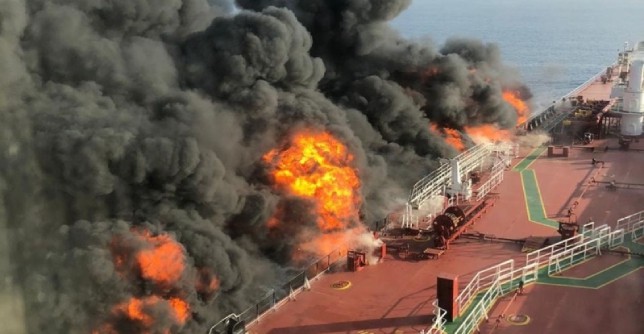U.S. officials say video shows an unexploded limpet mine being removed from the Kokuka Courageous, but the president of the ship’s operator said the crew reported the vessel was hit by a flying object.
After being victims of suspected attacks Thursday in the Gulf of Oman, the situation with the Front Altair is “still worrisome,” while the Kokuka Courageous was in stable condition and was being towed to a port on the eastern coast of the Arab peninsula, Royal Boskalis Westminster, the salvor for both ships, said Friday.
The fire aboard the Marshall Islands-flagged Front Altair has been extinguished, but that “does not mean that the risk has been fully eliminated” because the ship is carrying naphtha, a Boskalis spokesperson told American Shipper. The ship was reportedly carrying 75,000 of the flammable oil, and one of the vessel’s cargo holds on its starboard side was breached, the spokesperson said.
The salvor expects to have heat cameras in the area Saturday to verify there are no further hot spots in or around the vessel.
“If that is the case, still you need to be cautious that there is no gas accumulation with the potential of that catching fire. The next step would be to — with monitoring gas levels — board the vessel to ensure that there are no further potentially explosive situations on board, stabilize the cargo, stabilize the vessel. If all that goes well, you’d be looking at getting a tow line connected and hopefully bringing the ship to a safe port where you can discharge the cargo and hand the vessel back to the shipper/insurer company.”
Tank owner Frontline said Friday boundary cooling continues on the tanker and its 23 crew members are en route to Bandar Abbas after disembarking an Iranian naval ship at the Port of Jask.
The Japanese-owned Kokuka Courageous, which had “at least two parts where the damage to the hull was above the waterline” with a rupture in the engine room area, was being towed with all 21 crew members aboard, the Boskalis spokesperson said. It is expected to arrive at either Fujairah or Khor Fakkan, both in the United Arab Emirates, early next week.
“As to whether the vessel will physically go into port, at this point we’re not clear,” the spokesperson said. “It’s quite possible the cargo will be transferred on a ship to ship transfer basis, but that’s something we will establish as we approach the coastline.”
Secretary of State Mike Pompeo said Thursday that “it is the assessment of the United States government that the Islamic Republic of Iran is responsible for the attacks.” Iran has denied involvement in attacks of the tankers, which were in international waters about 10 nautical miles apart at the time of the distress calls Thursday morning, the U.S. Central Command said.
The command released images it said showed a “likely limpet mine” on the Kokuka Courageous and a video it said showed an Iranian patrol boat approach the vessel and remove an unexploded mine from the ship.
Yutaka Katada, president of the tanker’s operator Kokuka Sangyo, said the crew reported the ship was attacked by a flying object, according to media reports.
“I do not think there was a time bomb or an object attached to the side of the ship,” he said, according to The New York Times.
The Boskalis spokesperson said, “We are tasked with saving the vessel and its cargo. Obviously where possible we will work around potential evidence, but in many cases you won’t have the luxury to make that consideration. It’s about saving in a safe way for our own crew the ship and its cargo.”
The International Chamber of Shipping and the International Maritime Organization are among the organizations that expressed concern over the most recent suspected attacks on tankers, which came about a month after four ships were targeted in May near the Emirati port of Fujairah.
IMO Secretary-General Kitack Lim said Thursday he will carefully review the results of investigations “to consider if additional IMO action is warranted.”
Jakob Larsen, BIMCO’s head of security, said Friday on a Lloyd’s List podcast, “Right now the situation is about as close to armed conflict as we can get.”
He said there are steps vessels can take both at port and sea to mitigate potential risks. At port, ships could step up patrols, maneuver to make it more difficult for hostile divers to put a limpet mine on a ship and remain in close dialogue with authorities.
It’s “more difficult to take concrete measures” at sea, he said, but vessels could keep a distance to the Iranian coast and make preparations, including measures to consider the integrity of the ship.
The Norwegian Maritime Authority advised Norwegian-flagged vessels to “keep well clear of Iranian territorial waters.” It also requested vessels arriving in the Strait of Hormuz within certain boundaries to implement security measures described in their SSP according to ISPS/MarCes level No. 2.
More than one-third of all oil supplies shipped by sea pass through the Strait of Hormuz, Lloyd’s List editor Richard Meade said in the podcast. Due to the importance of the area, Larsen said he does not see tankers staying away from the Gulf of Oman.
“When threats increase, the freight rates also have a tendency to go up and that makes it more attractive for some owners to trade in the area,” Larsen said. “It is more dangerous for crew to operate in these waters. There’s no doubt about it. Of course, if you took the completely theoretical moral high you would say … to stay out. The other side of the coin to that is if you did that, then the perpetrators of these crimes would have successfully interrupted the trade in the area.”











